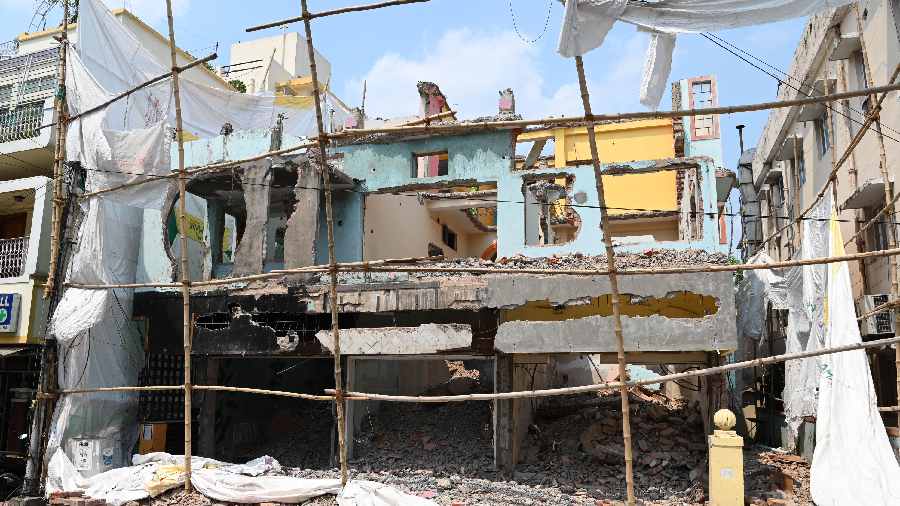Builders and contractors involved in building new houses by demolishing old existing structures in Salt Lake are not installing dust barriers and stacking up construction materials as well as equipment on pavements and roads, flouting norms laid down by the Bidhannagar Municipal Corporation.
In Salt Lake, over the past few years a trend has emerged whereby old buildings single and two-storeyed buildings are being razed to the ground before construction on building a new structure starts from ground up.
Over the past few years, a number of plots in Salt Lake have had their leasehold rights changed as the state government allowed transfer of leasehold rights for a fee of Rs 5 lakh per cottah. The fee is collected by the state urban development department.
Till 2012, transfer of leasehold rights for plots in Salt Lake were restricted to blood relations. However, there was rampant flouting of norms and transfer was done through unscrupulous means across the township. Realising that the government was losing out on revenue the state allowed the transfer of the leasehold rights over payment of fees.
According to a senior official of the urban development department, they receive around a dozen applications for transfer of leasehold rights almost every week.
This, the official added, translates into generation of a sizeable revenue for the department as well.
In Salt Lake, in a major number of cases after a house is sold an intensive demolition drive is carried out by a mix of labourers and heavy-duty equipment such as hydraulic payloaders and pneumatic hammers.
This results in alarmingly high noise levels coupled with dust generation that takes places not only on the demolition state but also during various phases of construction.
In more instances than one, the builders or contractors employed do not put up dust barriers in the form of plastic sheets or other coverings to prevent dust from rising up from the construction sites.
A senior official of the Bidhannagar Municipal Corporation said that the civic body had the power to first issue fines and then stop work at a construction site if rules are flouted.
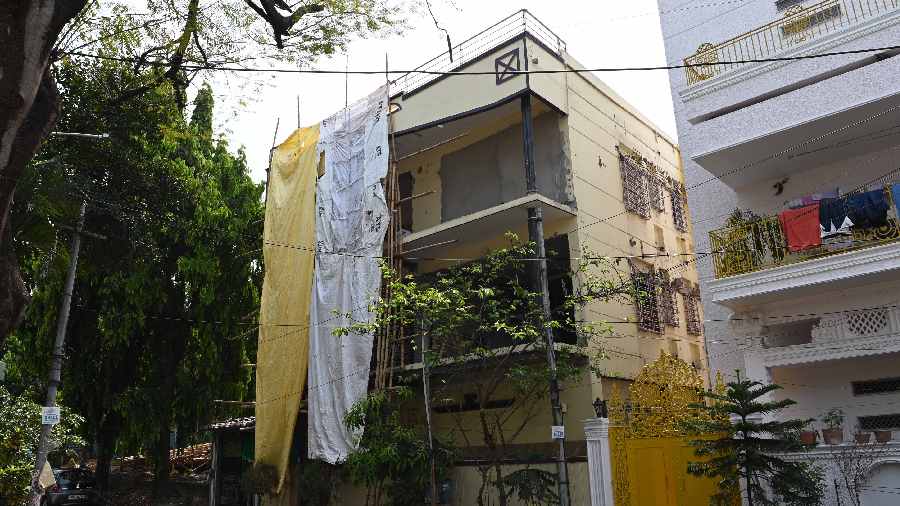
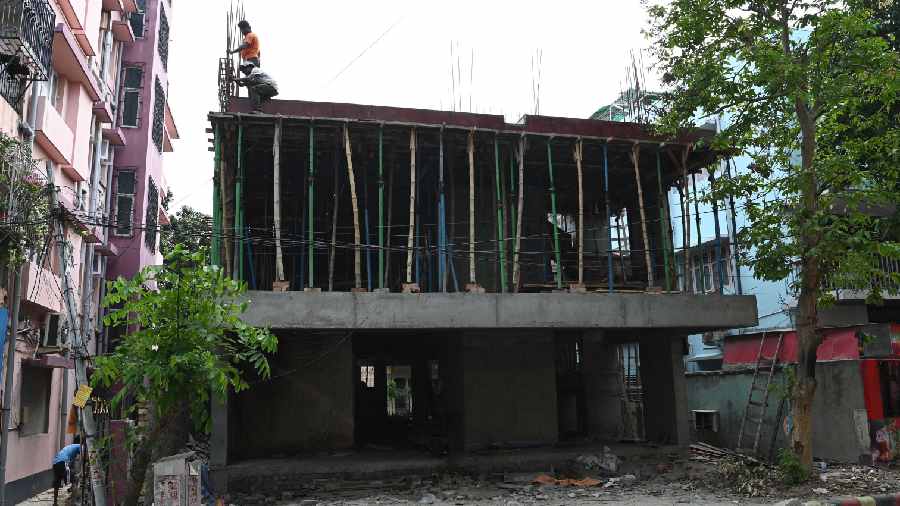
According to the official, the rules specify the need to have proper dust barriers installed at all times to ensure that other residents of the area are not inconvenienced.
Furthermore, stacking of building construction materials also requires a permit and that is valid for a limited number of days after which the permit needs to be renewed.
Although the guidelines are laid out clearly very few of them are actually followed on the ground.
Several residents that The Telegraph Salt Lake spoke to said that they were having to live under stressful conditions owing to noise as well as air pollution generated by construction activities in all three sectors of Salt Lake.
Debashis Mukherjee, a retired bank official who stays with his family in CF Block, said that several houses have changed hands and the new buyers have completely demolished the old houses or are in the process of doing so.
“This is being done before embarking on a massive new construction activity. This has led to frequent deployment of some heavy duty crusher machines and cutter machines,” he complained.
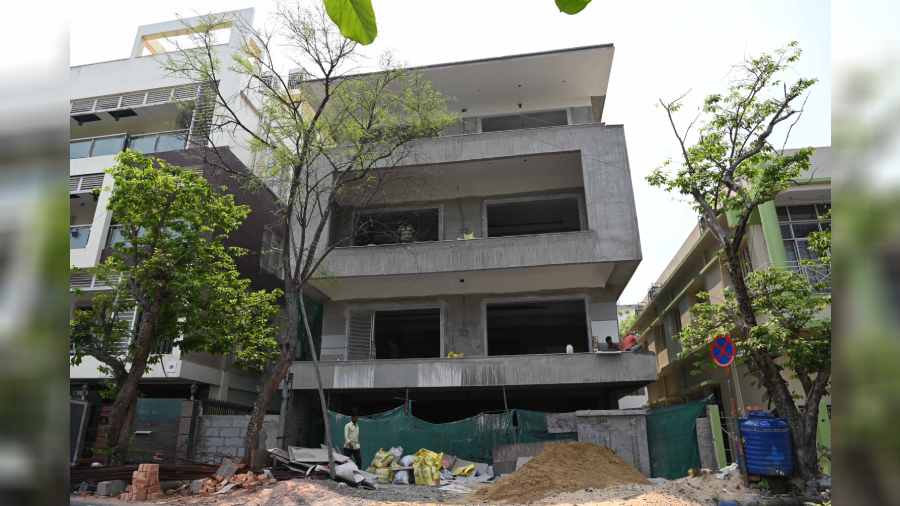
(Above and below) Houses being built on the same lane in EC Block. Pictures by Sanat Kumar Sinha
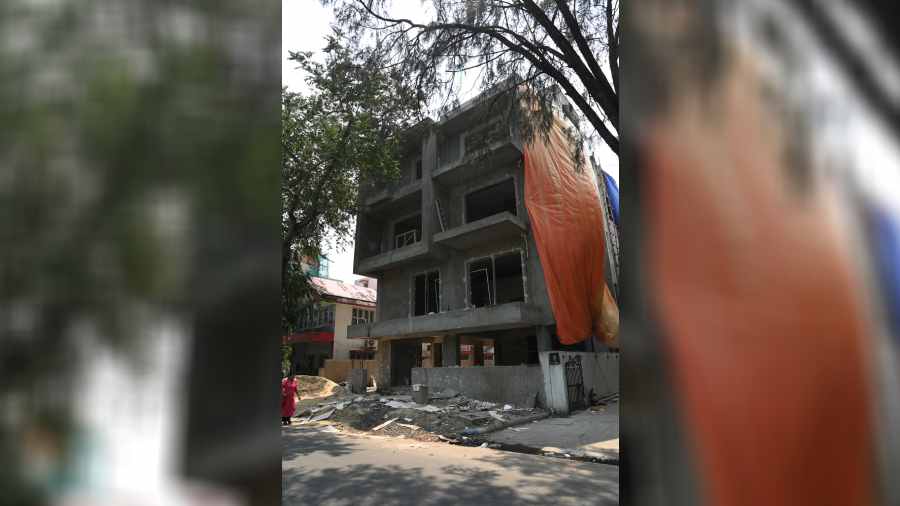
These have a deafening and nerve-shattering effect on residents of a large area and the plight of the houses in the immediate neighbourhood is indescribable. The residents of the houses cannot speak amongst themselves, cannot watch television programmes or receive a telephone call. Heart patients have palpitations and patients with other serious and very senior citizens face a lot of issues due to this and have to suffer unnecessarily,” Mukherjee told The Telegraph Salt Lake on Wednesday.
EC Block resident Somnath Bose echoed Mukherjee and said that in his locality too several older buildings have changed ownership and the new owners have already pulled down or were in the process of pulling them down before erecting multi-storied buildings on the plots.
“Even during the construction process, huge slabs of marble or granite stones are sliced using machines that create a lot of noise and on top of that iron rods and other materials are also sliced according to the needs of the builder. During demolition too first the building is pulled down generally using earthmoving equipment before the concrete and bricks are further pounded into smaller pieces so that they can be loaded up into trucks that drive in at night to collect the construction waste,” said Bose.
According to both of them, in several instances the construction waste is also dumped on the pavements and roads for days before they are disposed off.
FE Block resident Satish Kumar Pal said that he had a long-standing lung condition due to which he faces difficulty in breathing and the building opposite his house is being demolished.
“A fine layer of dust coats everything from the furniture to the the air-conditioning unit and fans. This translates into a dangerous situation for me as I am extremely allergic and reactive to dust,” said Kumar.
Mukherjee, who has shot off a letter to the pollution control board, said that despite block associations having full knowledge about the challenges faced by the residents due to these sort of construction activities, little action is taken on the ground.
A state PCB official said that they could do little in terms of pollution arising out of construction work.
“This falls under the purview of the local urban local body (ULB) like a municipal corporation or a municipality. In extreme cases, where the noise is deafening we might go there and examine the site but the onus of action lies on the ULB,” said the official.
A senior official of the Bidhannagar Municipal Corporation’s building department said that they can take action if they receive specific complaints against anyone who is flouting building norms.
“Till date, we have not received any complaint. If we get a complaint we will take the required action,” said the official.
The BMC building rules, however, do not specify anything to do with noise pollution levels.
But they do call for installation of “dust barriers”.
The rules also specify that construction materials cannot be stacked outside for more than three months or after the roof of the ground floor is ready, whichever is earlier.
“Builders are supposed to hang a cloth without holes that will prevent dust or construction materials from escaping the construction site. They are also supposed to sprinkle water at the site so that dust does not spread. Even materials stacked in front of the site should be covered with a plastic sheet or cloth,” said a BMC official.
“It is mentioned on the approved building plan that construction materials can be kept outside only for three months or till the roof casting of the ground floor is complete, whichever is earlier.”
But across Salt Lake, construction material is seen dumped on the pavement or the road in front of the structures whose second, third or even upper floors are complete.
On same boat in New Town
Construction materials like sand, stone chips and bricks, and construction waste dumped on roads are a common sight in New Town, also.
Retired central government employee Satyajit Acharjee who lives in New Town’s AL Block, said a construction site next to his building had no dust barrier.
Acharjee said he had lodged complaints with the New Town Kolkata Development Authority (NKDA), but the issue has not been addressed yet.
“I am a cancer patient and my wife suffers from a respiratory problems. We have placed repeated requests but no action has been taken yet. We are finding it difficult to live like this in a township that prides itself in being a planned area,” said Acharjee.
According to NKDA regulations, builders or contractors must cover construction sites with sheets made of plastic or other materials to prevent dust from spreading across the neighbourhood.
“We also advise builders to spray water on construction sites to reduce the dust cloud,” said an NKDA official.
Asked about Acharjee’s complaints, the official promised action. “We had asked the builder to cover the construction site with plastic sheets. We will follow it up with him again,” said the official.
Write to saltlake@abp.in
